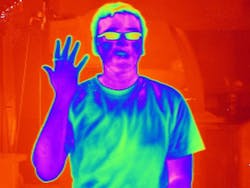Researchers create first high-performance IR camera based on Type-II InAs/GaSb superlattices
Evanston, IL--Researchers at Northwestern University have created a new IR camera based on Type-II indium arsenide/gallium antimonide (InAs/GaSb) superlattices that produces much higher-resolution images than previous IR cameras.1 Created by Manijeh Razeghi and her group, the long-wavelength IR (LWIR) focal-plane-array camera provides a 16-fold increase in the number of pixels in the image.
Mercury-free
The goal of the research is to offer a better alternative to existing LWIR cameras, which, with their thermal-imaging capabilities, are used in everything from electrical inspections to security and nighttime surveillance. Current LWIR cameras are based on mercury cadmium telluride (MCT) materials, but the Type-II superlattice is mercury-free, more robust, and can be deposited with better uniformity. This will significantly increase yield and reduce camera cost once the technology goes commercial.
"Not only does it prove Type-II superlattices as a viable alternative to MCT, but also it widens the field of applications for IR cameras," said Razeghi. "The importance of this work is similar to that of the realization of megapixel visible cameras in the last decade, which shaped the world's favor for digital cameras."
Superlattice
Type-II InAs/GaSb superlattices were first invented by Nobel laureate Leo Esaki in the 1970s, but it has taken time for the material to mature. The LWIR detection mechanism relies on quantum size effects in an artificial layer sequence (superlattice) to tune the wavelength sensitivity and demonstrate high efficiency. Razeghi's group has been instrumental in pioneering the recent development of Type-II superlattices, having demonstrated the world's first Type-II-based 256 x 256 pixel IR camera just a few years ago.
"Type-II is a very interesting and promising new material for IR detection," Razeghi said. "Everything is there to support its future: the beautiful physics, the practicality of experimental realization of the material. It has just taken time to prove itself, but now the time has come."
Tremendous obstacles, especially in the fabrication process, had to be overcome to ensure that the 1024 x 1024 pixel Type-II superlattice-based camera would have equivalent performance as the previously realized 320 x 256 pixel cameras. Operating at 81 K, the new camera can collect 78% of the light and is capable of showing temperature differences as small as 0.02° C.
REFERENCE:
1. Paritosh Manurkar et al., Applied Physics Letters, Volume 97, Issue 19, p. 193505 (2010).

John Wallace | Senior Technical Editor (1998-2022)
John Wallace was with Laser Focus World for nearly 25 years, retiring in late June 2022. He obtained a bachelor's degree in mechanical engineering and physics at Rutgers University and a master's in optical engineering at the University of Rochester. Before becoming an editor, John worked as an engineer at RCA, Exxon, Eastman Kodak, and GCA Corporation.
